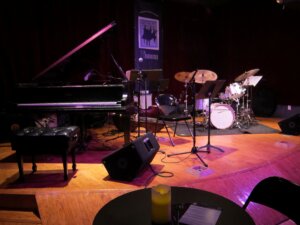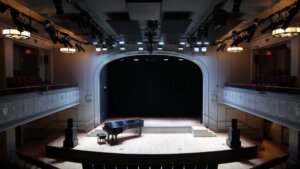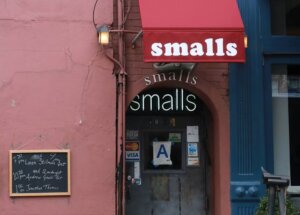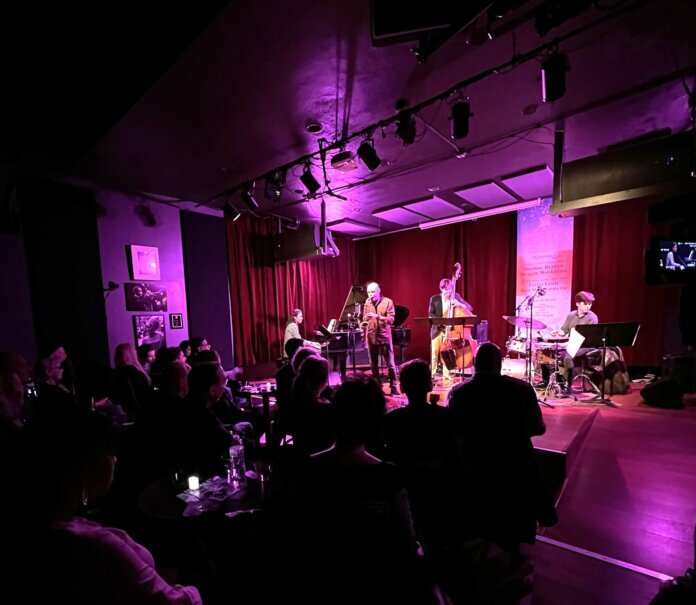New York has been the world capital of jazz for several decades. After originating in New Orleans and spreading to Chicago and Kansas City, with some influence in California, jazz finally found its home in New York City, where it has remained ever since. Every connoisseur, scholar, or enthusiast knows this great metropolis is where the most important stylistic directions in modern and contemporary jazz are born and develop—and sometimes die.
Another important aspect is the tradition of Broadway musicals, which have always been a breeding ground for famous songwriters who forged what is commonly referred to as the “Great American Songbook,” an endless “hall of fame” of songs that all jazz musicians know and love to tackle with a variety of arrangements. George Gershwin, Jerome Kern, Richard Rodgers, Lorenz Hart, Irving Berlin, Johnny Mercer, and Cole Porter were all New Yorkers, or soon became so.
Today, the same is true for any musician who wants to make a name for themselves, learn something new, refine their style, or simply compete with others in a friendly atmosphere. This happens every evening in the countless clubs throughout the city, from Manhattan to Brooklyn, the Bronx, and Queens, as well as across the Hudson River in New Jersey. As a result, walking through New York’s streets in the evening is like walking through a boundless jazz festival with something for everyone. In addition to large venues devoted entirely to this music, restaurants, bars, and even hotel lobbies offer concerts by young and established artists alike.
I personally remember seeing a trio composed of Joe Locke, Lew Soloff, and François Moutin play one evening years ago in a noisy downtown restaurant that was usually unconnected with any kind of live performance. They were great musicians, but they struggled to be heard over the noise. Even today, the Cellar Dog (formerly the Fat Cat) in Greenwich Village holds concerts in a large billiards room with ping-pong tables and other games. The stage is off to the side, and the players pay little attention to it. But that’s New York: impertinent and warm, cynical and exciting, respectful and indifferent all at once. Yet it is indispensable for those who love music. It fears no comparison with any other city in the world.
However, the arrival of the pandemic was like a silent tornado that claimed victims and left indelible marks. Some highly regarded, historic venues—such as the 55 Bar and the Jazz Standard, which are very different but both vital and well-known places—have unfortunately closed their doors for good. New venues have since opened, but they will have to work hard to acquire the charm of certain legendary clubs. At the 55 Bar, you could listen to Uri Caine while sitting next to Cecil Taylor, a frequent visitor who loved the place and would periodically go outside for a cigarette. At the Jazz Standard, you could enjoy a pleasant conversation with Michael Cuscuna, a well-known producer, or Bruce Lundvall, the former director of Blue Note Records. Neither of them are with us today. Time passes, leaving traces that are covered in the blink of an eye.
One surprising thing you quickly learn in New York is that new paint is not applied by scraping off the old paint but by brushing it over. It has always been this way, both literally and metaphorically. In any case, that’s what they said about the years of the pandemic.
Let’s take a closer look at how the jazz club scene changed immediately after the pandemic ended, for the benefit of those who want to visit the city and those who remember it as it was in the old days. Once the emergency was over, the public returned in droves, and numbers continued to grow. Today, it can be difficult to find a seat in the most popular venues unless you book well in advance. As in all other commercial activities, prices have risen dramatically. To get into one of the major clubs, it now costs around $40-$60 or more, to which you must add the mandatory cover charge. With a drink and tip, you’ll spend at least $60, or $120 with dinner. There are usually two evening sets, sometimes three, so admission is strictly regulated, and there are likely to be lines (which can be exhausting in winter).
However, the main purpose of this article is to explore places where you can listen to new jazz and see emerging musicians and more experimental styles, venues for enthusiasts and connoisseurs. Leaving aside the four well-known clubs—the Village Vanguard, the Blue Note, Birdland, and Dizzy’s Club at Jazz at Lincoln Center—along with the bars, restaurants, and other smaller venues, there are five “top” places to closely follow new jazz trends: the Jazz Gallery, Smalls, Mezzrow, Smoke, and Roulette in Brooklyn.
One could also add the “perennially reborn” Minton’s Playhouse in Harlem. Despite its legendary name, which takes us back to the golden years of Monk and bebop, the venue has changed management and owners so many times that stability and excellent programming seem unlikely. For now, it exists in limbo, awaiting definitive recognition. A visit certainly won’t hurt, especially since you can experience the atmosphere of yesteryear and occasionally enjoy good performances, in addition to discovering new talent. This is not the case for the Cotton Club or the Lenox Lounge in Harlem. The Cotton Club retains only its name from the past, and the Lenox Lounge, after years of struggle, was recently demolished. Until a few years ago, you could sit on Billie Holiday’s favorite sofa, as I did. As we all know, the “unwritten” law of New York can be relentless.
Returning to the present and the five venues mentioned above, it would be useful to start with the most renowned and perhaps unique: The Jazz Gallery. This small yet charming club is located downtown on 27th Street between Broadway and Fifth Avenue. Spread over two floors, one of which is reserved for reception, drinks, and special events, the Jazz Gallery can accommodate about a hundred people. The room is divided in half with reserved tables and chairs. You go up to the fifth floor from an unassuming entrance, and upon arrival, you immediately realize that you are in a place where art thrives. The Jazz Gallery has two features that distinguish it from other jazz venues: it receives state subsidies from the National Endowment for the Arts, the state, and the city of New York, and it awards grants to encourage creative production by musicians. The artistic director, Rio Sakairi, is a Japanese woman who moved to America more than two decades ago. We asked her to describe the club’s activities.

When did the Jazz Gallery begin, and what makes it different from other clubs?
“The Jazz Gallery was founded in 1995 as a nonprofit. It was the vision of Dale Fitzgerald, who sadly passed away in 2015. He believed in viewing jazz holistically, in connection with the visual and literary arts. I joined in 2000, when we were in financial crisis. We had very few resources, but I worked to find solutions. Jazz is democratic and draws from many influences. To be a good musician, you must first be a good listener.”
Did your background influence your involvement in jazz?
“Definitely. Japanese people often have a strong affinity for jazz, though it’s mostly for traditional forms. I came to New York at eighteen to study psychology, but life had other plans. I never imagined I would become the artistic director of a jazz club.”
You offer grants to young artists. How does that work?
“We started our grant program in 2000. Jason Moran, Dafnis Prieto, Rudresh Mahanthappa, and Jason Lindner were among the first recipients. We don’t accept applications. After a couple of years of playing here, we might offer an artist a $10,000 grant to develop a one-hour performance. We want to support bold new ideas.”

Do you record concerts?
“Yes, for archival purposes. Artists receive copies upon request and can release them with a ‘Live at Jazz Gallery’ label.”
How do you select performers?
“Some approach us, some we discover elsewhere. There’s no fixed rule.”
And beyond concerts?
“We host listening sessions and informal talks with musicians, which audiences love. It gives insight into their influences and creative processes.”
Do musicians feel respected here?
“We believe in fair compensation and a nurturing environment. Along with public support, we rely on private donations and membership programs. Students can attend for just $10.”
Under the guidance of Rio Sakairi, the Jazz Gallery has become a key reference point for young musicians and for the most stylistically sophisticated jazz in New York. A comparable venue is Roulette Intermedium, located just across the bridge in Brooklyn. Although Roulette is technically a medium-sized theater, it originated as a small club in Manhattan’s SoHo neighborhood. Economic challenges and the need for a stable space that could support its cultural mission led to its relocation—a decision that quickly proved successful.

Today, the theater-club is situated in one of Brooklyn’s most cultured and visually striking areas, home to the BAM (Brooklyn Academy of Music) performing arts center. BAM’s beautiful theaters host concerts, plays, dance, films, and other multidisciplinary works. The neighborhood is so vibrant that it rivals anything Manhattan has to offer—aside from Lincoln Center, of course. Adjacent to BAM stands the imposing Barclays Center, a 20,000-seat indoor arena that opened in 2012 and now hosts basketball games, boxing matches, and major pop and rock concerts. Just a few blocks away, along the broad avenue of Atlantic Avenue, Roulette contributes its own unique presence with concerts that feature contemporary and avant-garde jazz, as well as experimental and classical music.
As our most attentive readers will know, Roulette is now the main home of the annual Vision Festival, which is dedicated primarily to free jazz. At the same time, BAM and the surrounding venues host the Long Play Festival, a celebration of contemporary music organized by the acclaimed composer collective Bang on a Can. We closely follow both of these events each year, as they represent the pride of New York’s richly diverse avant-garde music scene.
Beyond the Vision Festival, Roulette regularly presents concerts by some of the most visionary musicians of our time. John Zorn and Henry Threadgill often perform here, as do Bill Frisell, Mary Halvorson, and the Philip Glass Ensemble. These are artists at the forefront of today’s creative music. In this sense, Roulette is an indispensable catalyst—and it is easily accessible by subway from Manhattan.
Back in the heart of the Big Apple, we move uptown to the Upper West Side and Smoke, one of the city’s most beautiful and active clubs for new jazz. Located on Broadway at the corner of 106th Street, Smoke sits in a quiet, residential neighborhood—not the sort of place where one would expect to find a jazz club open late into the night. Smoke has experienced its share of ups and downs, including a fire and a long closure during the pandemic. But it has returned stronger than ever, having expanded its space, renovated its interiors, and added an excellent dining menu.
The club is run by Paul Stache, originally from Germany, along with his wife, Molly Sparrow Johnson. We asked Paul to tell us more about the evolution and vision behind this remarkable venue.
Smoke is quite removed from downtown Manhattan. Was it a risky bet?
“Very much so. We opened in 1999. I had just moved from Berlin, where I fell in love with jazz thanks to my father. I worked as a bartender at Augie’s, the bar that used to occupy this space. Junior Cook was playing on my first day. Then I decided to reopen the space with a new vision.”
Why the name ‘Smoke’?
“It’s a tribute to Paul Auster, who used to hang out at Augie’s and wrote the film Smoke. The character Auggie Wren was inspired by Augie himself. At first, people smoked inside, talked over the music—but jazz endured.”
How do you choose who performs?
“Style doesn’t matter. Quality does. Vijay Iyer, Brad Mehldau, and Branford Marsalis have all played here. We also promote new talent.”
The venue suffered a fire in 2009, and later the pandemic. How did you survive?
“It was tough. But we rebuilt, expanded, and improved. The restaurant next door closed, so we acquired that space. We used pandemic relief funds to invest in the future.”
Prices are higher now, and dinner is mandatory. Why?
“Without dinner service, we couldn’t meet our costs. But we offer great food and world-class music. Two separate spaces mean no bar noise interferes with the show.”
Smoke also produces records. What led to that?
“We began about ten years ago. Originally, it was studio work, but now we focus on live recordings. The acoustics are excellent, and the performances are magic.”
From the sophistication of Smoke and the quiet of the Upper West Side, we descend into the chaotic and exhilarating world of Greenwich Village. Now a vibrant hotspot for jazz in New York, the area was once the epicenter of folk and rock. Music can be found everywhere here. As previously noted, bypassing the “giants”—the Village Vanguard and the Blue Note—for this special report, we arrive at the most celebrated venue among young audiences and emerging musicians: Smalls.

Just a stone’s throw from the Vanguard and a short walk from the Blue Note, Smalls lives up to its name: it holds around fifty people, perhaps slightly more. But in terms of the volume and caliber of music performed, it is anything but small. You enter through a modest door on 10th Street, just off Seventh Avenue, descending into what was likely once a cellar. Seating is arranged wherever it fits, and a lively bar hums in the background. Posters plaster the walls, and a mirror placed beside the piano allows distant guests to watch the pianist’s hands. The venue has an unmistakable charm. The closeness of the band to the audience creates a communal feeling that makes everyone feel part of the same scene.
Despite a recent increase in prices, Smalls continues to attract a loyal stream of patrons and musicians. The club hosts four sets nightly, starting at 7:30 p.m. and running well into the early morning hours. On weekends, staying until the final set means emerging into the quiet breath of New York’s dawn. While jazz legends like George Coleman occasionally perform here, nearly every prominent jazz artist working today has passed through its doors. Listing them all would fill a full page of this magazine. Though Smalls may not yet hold the same legendary status as the Village Vanguard, it unquestionably has the potential to achieve it.
The club’s current owner and manager, Spike Wilner, is a distinguished pianist with a deep passion for bop and hard bop, particularly the work of Hampton Hawes. In addition to his artistic credentials, Wilner has demonstrated a keen business sense and a flair for digital innovation. He was among the first to livestream club performances and began producing a long-running series of live albums in 2008. Smalls, founded in 1994, recently celebrated its 30th anniversary. Wilner became co-owner in 2001 and took over fully as sole owner and artistic director in 2019. His mission has always been to preserve the club’s core values: affordable prices and showcasing emerging talent. The club also hosts regular jam sessions to encourage the artistic development of young musicians. The success of this approach is evident: sometimes the line to enter stretches out the door.
In 2011, Wilner opened an even smaller, but equally beloved venue called Mezzrow, located directly across Seventh Avenue. Named after the colorful clarinetist Mezz Mezzrow, active many decades ago, Mezzrow feels like a true basement: barely enough room for a piano and a handful of tables. And yet, it has won over New York’s music lovers—including many from the younger generation—thanks to its intimate setting. The space recalls the legendary Bradley’s, a late-night Union Square haunt where great musicians would drop in for informal sets in a magical atmosphere. Mezzrow could be seen as a revival of that spirit, with similar intentions.

Pianists especially love it, as the audience sits just a few feet away, completely absorbed in the music and respectful of the performance. Unlike Smalls, Mezzrow offers a more refined, hushed environment—an oasis of concentrated listening in a city that never sleeps, full of energy and endless musical surprises.
In conclusion, the city’s jazz scene remains as vital as ever. While old landmarks fade or transform, new spaces emerge with fresh energy. These five clubs—The Jazz Gallery, Roulette, Smoke, Smalls, and Mezzrow—are the most vibrant hubs of creative jazz in New York today. They are more than just venues; they are communities, places where the music lives, breathes, and evolves.
Whether you’re a seasoned jazz fan or a curious newcomer, spending time in any of these clubs is a way to connect with the pulse of the city—and with the spirit of a music that, in New York, never truly stops.
